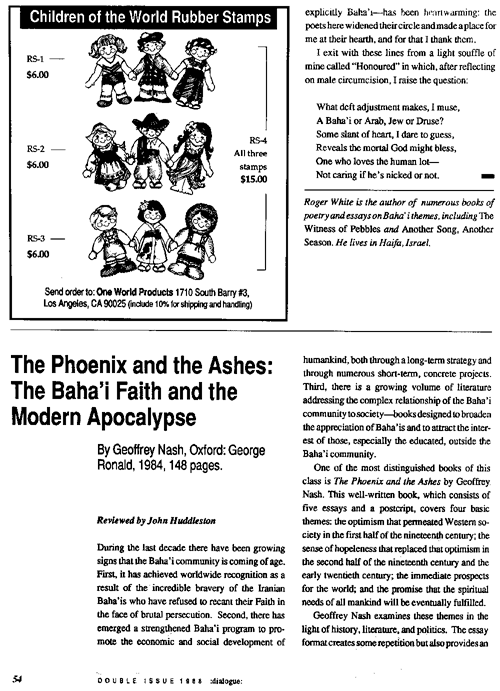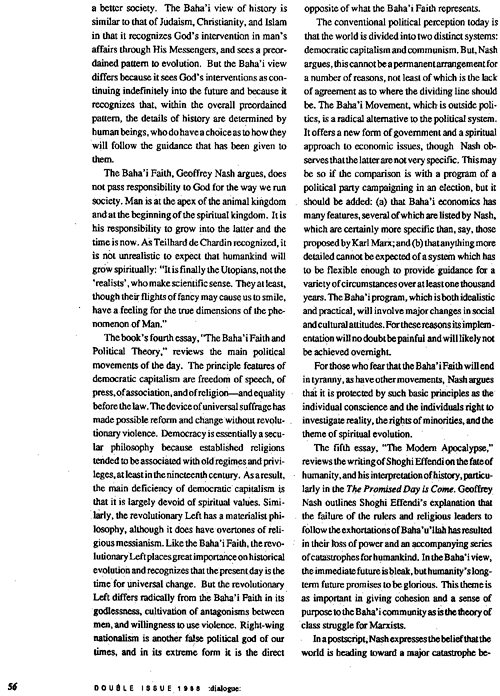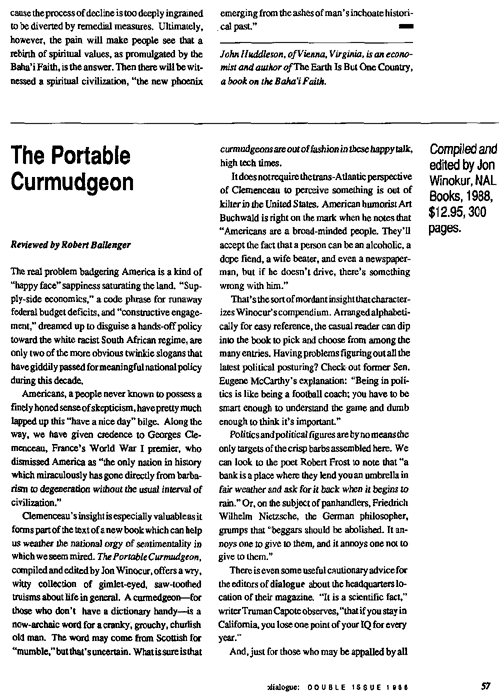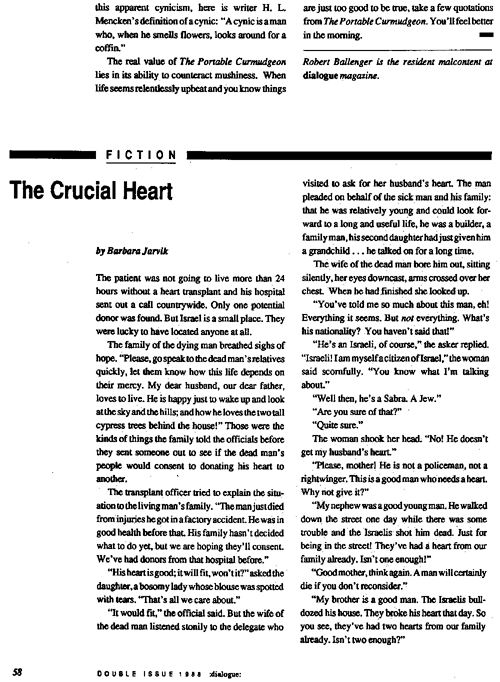
|
|
Abstract: 19th-century optimism, disillusionment with contemporary society, philosophy of history, political theory, Arthur Koestler and Aldous Huxley, and the future of humanity. Includes review of Jon Winokur's The Portable Curmudgeon, by Robert Ballenger. Notes: See also list of dialogue articles or image scans. |
Phoenix and the Ashes: The Bahá'í Faith and the Modern Apocalypse, by Geoffrey Nash:
Review
by John Huddleston
published in dialogue, 2:2-3, pages 54-57Los Angeles: 1988
1. Review of Phoenix and the Ashes, in dialogue 2:2-3, pp. 54-57
Phoenix and the Ashes: The Bahá'í Faith and the Modern ApocalypseAuthor: Geoffrey Nash
Publisher: Oxford: George Ronald, 1984
Review by: John Huddleston
Review published in: dialogue magazine 2:2-3 (1988)
During the last decade there have been growing signs that the Bahá'í community is coming of age. First, it has achieved worldwide recognition as a result of the incredible bravery of the Iranian Bahá'ís who have refused to recant their Faith in the face of brutal persecution. Second, there has emerged a strengthened Bahá'í program to promote the economic and social development of humankind, both through a long-term strategy and through numerous short-term, concrete projects. Third, there is a growing volume of literature addressing the complex relationship of the Bahá'í community to society—books designed to broaden the appreciation of Bahá'ís and to attract the interest of those, especially the educated, outside the Bahá'í community.
One of the most distinguished books of this class is The Phoenix and the Ashes by Geoffrey Nash. This well-written book, which consists of five essays and a postscript, covers four basic themes: the optimism that permeated Western society in the first half of the nineteenth century; the sense of hopelessness that replaced that optimism in the second half of the nineteenth century and the early twentieth century; the immediate prospects for the world; and the promise that the spiritual needs of all mankind will be eventually fulfilled.
Geoffrey Nash examines these themes in the light of history, literature, and politics. The essay format creates some repetition but also provides an unusual depth that comes from the multiplicity of approaches. The author’s low-key tone is likely to attract open-minded non-Bahá'ís. The book also has the high production standards we have come to expect from its publisher: a thought-provoking cover; good, clear print; strong binding; and a reasonable price. The only shortcoming is the absence of an index or detailed table of contents.
The book’s first essay, “The Lost Hope of the Nineteenth Century,” begins with a review of early nineteenth-century romanticism, showing how its essential optimism and spirituality were based on a continuation of tolerance, a love of freedom, and a respect for the individual themes adapted from the Enlightenment movement of the eighteenth century. The essay then describes the more pessimistic view of life that developed among intellectuals, such as Henrik Ibsen, in the latter half of the nineteenth century as religious conviction faltered in the face of a materialistic philosophy and scientific advances. There were attempts to revitalize religion but most of those efforts were backward looking and, therefore, doomed to fail.
The one exception was the Bahá'í Faith, whose remarkably advanced teachings looked to the future. Unfortunately, though some educated Westerners knew about the new Faith, they mistakenly assessed it as little more than a rather dramatic reform movement within Islam. As a result religion continued to decline, and society lost its sense of purpose and cohesion.
The main subject matter of the second essay, “From Vision to Nightmare,” is disillusionment with present-day society as described by five leading writers of our time. This essay is perhaps the most original and stimulating of the five. Three of the writers—George Orwell, Arthur Koestler, and Alexander Solzhenitsyn—discuss the flaws in communism that they found through personal experience. In Animal Farm and other works, George Orwell satirizes the shallowness of modern society, the gullibility of the vast majority, and the terrible hypocrisy of the communist movement as epitomized in the mock slogan, “All animals are equal but some are more equal than others.”
In Darkness at Noon, Arthur Koestler criticizes the revolutionary and seductive principle that the end justifies the means and concludes: “And perhaps reason alone was a defective compass, which led one on such a winding, twisted course that the goal finally disappeared in the mist.” Disillusionment with Communism becomes virtually complete in the detailed description by Alexander Solzhenitsyn of the Russian gulag ,the ultimate nightmare of a dream gone wrong.
The final two writers whose works are analyzed in “From Vision to Nightmare”—Henry Miller and Aldous Huxley—are equally critical of Western capitalist society. Though remembered mostly for the strong language in his “Tropic” novels, Miller’s primary message was indignation at the misery inflicted on the poor by unbridled capitalism and by insensitivity to the cultures of black peoples and the American Indians. He spoke harshly of American society as being like Moloch, devouring humanity in pursuit of all that is useless. He recognized how different were the teachings of the Bahá'í Faith and wrote: “It is for this reason that the Bahá'í movement is destined to outlast all other religious organizations on this continent.”
In Brave New World, Aldous Huxley shows that, if society concentrates only on material desires and achieves its goal, our culture will lack depth and ultimately will fail because it does not meet the deep spiritual needs we all have. Nash concludes that all five writers recognize, explicitly or implicitly, that man descends into savagery when civilization has no moral core. As Henry Miller puts it, “We are kept alive by men of faith, men of vision. They are like vital germs in the endless process of becoming. Make room, then, for the lifegiving ones.”
Nash’s third essay, “The Bahá'í Faith and Philosophy of History,” compares the Bahá'í view of history with that of other religions and humanism. Some religions such as Hinduism and Buddhism have little concern with history. Judaism, Christianity, and Islam, however, do have a historical dimension. Each sees the intervention of God in man’s affairs but concludes that such interventions have been essentially completed until the Day of Judgment; as a result all three religions tend to look backward rather than forward. This has contributed to their failure to capture the minds and hearts of the many who have turned instead to a humanist faith in science that it is believed, will ultimately lead to a better society. The Bahá'í view of history is similar to that of Judaism, Christianity, and Islam in that it recognizes God’s intervention in man’s affairs through His Messengers, and sees a preordained pattern to evolution. But the Bahá'í view differs because it sees God’s interventions as continuing indefinitely into the future and because it recognizes that, within the overall preordained pattern, the details of history are determined by human beings, who do have a choice as to how they will follow the guidance that has been given to them.
The Bahá'í Faith, Geoffrey Nash argues, does not pass responsibility to God for the way we run society. Man is at the apex of the animal kingdom and at the beginning of the spiritual kingdom. It is his responsibility to grow into the latter and the time is now. As Teilhard de Chardin recognized, it is not unrealistic to expect that humankind will grow spiritually: “It is finally the Utopians, not the ‘realists,’ who make scientific sense. They at least, though their flights of fancy may cause us to smile, have a feeling for the true dimensions of the phenomenon of Man.”
The book’s fourth essay, “The Bahá'í Faith and Political Theory,” reviews the main political movements of the day. The principle features of democratic capitalism are freedom of speech, of press, of association, and of religion—and equality before the law. The device of universal suffrage has made possible reform and change without revolutionary violence. Democracy is essentially a secular philosophy because established religions tended to be associated with old regimes and privileges, at least in the nineteenth century. As a result, the main deficiency of democratic capitalism is that it is largely devoid of spiritual values. Similarly, the revolutionary Left has a materialistic philosophy, although it does have overtones of religious messianism. Like the Bahá'í Faith, the revolutionary Left places great importance on historical evolution and recognizes that the present day is the time for universal change. But the revolutionary Left differs radically from the Bahá'í Faith in its godlessness, cultivation of antagonisms between men, and willingness to use violence. Right-wing nationalism is another false political god of out times, and in its extreme form it is the direct opposite of what the Bahá'í Faith represents.
The conventional political perception today is that the world is divided into two distinct systems: democratic capitalism and communism. But, Nash argues, this cannot be a permanent arrangement for a number of reasons, not least of which is the lack of agreement as to where the dividing line should be. The Bahá'í Movement, which is outside politics, is a radical alternative to the political system. It offers a new form of government and a spiritual approach to economic issues, though Nash observes that the latter are not very specific. This may be so if the comparison is with a program of a political party campaigning in an election, but it should be added: (a) that Bahá'í economics has many features, several of which are listed by Nash, which are certainly more specific than, say, those proposed by Karl Marx; and (b) that anything more detailed cannot be expected of a system which has to be flexible enough to provide guidance for a variety of circumstances over at least one thousand years. The Bahá'í program, which is both idealistic and practical, will involve major changes in social and cultural attitudes. For these reasons, its implementation will no doubt be painful and will likely not be achieved overnight.
For those who fear that the Bahá'í Faith will end in tyranny, as have other movements, Nash argues that it is protected by such basic principles as the individual conscience and the individual’s right to investigate reality, the rights of minorities, and the theme of spiritual evolution.
The fifth essay, “The Modern Apocalypse,” reviews the writing of Shoghi Effendi on the fate of humanity, and his interpretation of history, particularly in The Promised Day is Come. Geoffrey Nash outlines Shoghi Effendi’s explanation that the failure of the rulers and religious leaders to follow the exhortations of Bahá'u'lláh has resulted in their loss of power and an accompanying series of catastrophes for humankind. In the Bahá'í view, the immediate future is bleak, but humanity’s long-term future promises to be glorious. This theme is as important in giving cohesion and a sense of purpose to the Bahá'í community as is the theory of class struggle for Marxists.
In a postscript, Nash expresses the belief that the world is heading toward a major catastrophe because the process of decline is too deeply ingrained to be diverted by remedial measures. Ultimately, however, the pain will make people see that a rebirth of spiritual values, as promulgated by the Bahá'í Faith, is the answer. Then there will be witnessed a spiritual civilization, “the new phoenix emerging from the ashes of man’s inchoate historical past.”
John Huddleston, of Vienna, Virginia, is an economist and author of The Earth Is But One Country, a book on the Bahá'í Faith.
2. Review of The Portable Curmudgeon, in dialogue 2:2-3, pp. 57-58
The Portable CurmudgeonEdited/compiled by: Jon Winokur
Publisher: New American Library, 1987
Review by: Robert Ballenger
The real problem badgering America is a kind of “happy face” sappiness saturating the land. “Supply-side economics,” a code phrase for runaway federal budget deficits, and “constructive engagement,” dreamed up to disguise a hands-off policy toward the white racist South African regime, are only two of the more obvious twinkie slogans that have giddily passed for meaningful national policy during this decade.
Americans, a people never known to possess a finely honed sense of scepticism, have pretty much lapped up this “have a nice day” bilge. Along the way, we have given credence to Georges Clemenceau, France’s World War I premier, who dismissed America as “the only nation in history which miraculously has gone directly from Barbarism to degeneration without the usual interval of civilization.”
Clemenceau’s insight is especially valuable as it forms part of the text of a new book which can help us weather the national orgy of sentimentality in which we seem mired. The Portable Curmudgeon, compiled and edited by Jon Winocur, [sic] offers a wry, witty collection of gimlet-eyed, saw-toothed truisms about life in general. A curmudgeon—for those who don’t have a dictionary handy—is a now-archaic work for a cranky, grouchy, churlish old man. The word may come from Scottish for “mumble,” but that’s uncertain. What is sure is that curmudgeons are out of fashion in these happy talk, high-tech times.
It does not require the trans-Atlantic perspective of Clemenceau to perceive something is out of kilter in the United States. American humorist Art Buchwald is right on the mark when he notes that “Americans are a broad-minded people. They’ll accept the fact that a person can be an alcoholic, a dope fiend, a wife beater, and even a newspaperman, but if he doesn’t drive, there’s something wrong with him.”
That’s the sort of mordant insight that characterizes Winocur’s compendium. Arranged alphabetically for easy reference, the casual reader can dip into the book to pick and choose from among the many entries. Having problems figuring out all the latest political posturing? Check out former Sen. Eugene McCarthy’s explanation: “Being in politics is like being a football coach; you have to be smart enough to understand the game and dumb enough to think it’s important.”
Politics and political figures are by no means the only targets of the crisp barbs assembled here. We can look to the poet Robert Frost to note that “a bank is a place where they lend you an umbrella in fair weather and ask for it back when it begins to rain.” Or, on the subject of panhandlers, Friedrich Wilhelm Nietzsche, the German philosopher, grumps that “beggars should be abolished. It annoys one to give to them, and it annoys one not to give to them.”
There is even some useful cautionary advice for the editors of dialogue about the headquarters location of their magazine. “It is a scientific fact,” writer Truman Capote observes, “that if you stay in California, you lose one point of your IQ for every year.”
And, just for those who may be appalled by all this apparent cynicism, here is writer H. L. Mencken’s definition of a cynic: “A cynic is a man who, when he smells flowers, looks around for a coffin.”
The real value of The Portable Curmudgeon lies in its ability to counteract mushiness. When life seems relentlessly upbeat and you know things are just too good to be true, take a few quotations from The Portable Curmudgeon. You’ll feel better in the morning.
Robert Ballenger is the resident malcontent at dialogue magazine.
 click for larger image |
 click for larger image |
 click for larger image |
 click for larger image |
 click for larger image |
|
|